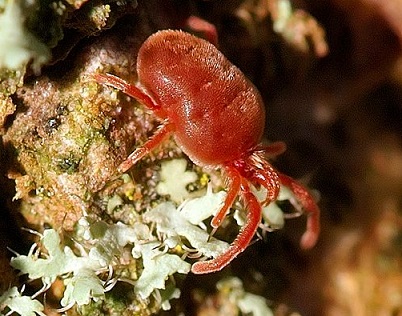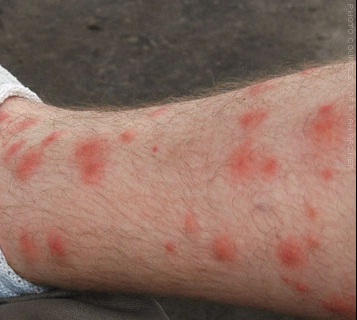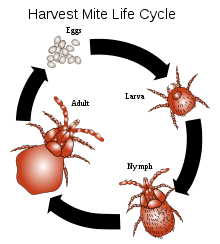 Trombiculidae AKA chigger, berry bug, harvest mite, red bug, scrub-itch, and aoutas Trombiculidae AKA chigger, berry bug, harvest mite, red bug, scrub-itch, and aoutas 
 

Chigger bites There are many names for this tiny, nasty critter! If you have ever had an encounter with chiggers you know how miserable they are. This summer my husband and I suffered terribly with them. I stopped counting after 150 chigger bits on my body. The itching lasted for over two months. Nasty, nasty, nasty! So, what are chiggers and how do you avoid them? (To avoid them spray yourself with a deet product, wear high boots with your pants tucked into your socks! Take a hot shower as soon as you get home after being in the woods or near water such as streams or rivers. That helps.)
The distribution of trombiculid species, which is nearly everywhere in the world.
Trombiculidae is a family of mites called trombiculid mites (also called berry bugs; harvest mites; red bugs; scrub-itch mites; and aoutas. In their larval stage, those species which bite their host and "causes intense irritation" or "a wheal, usually with severe itching and dermatitis," are called chiggers. Trombiculidae live in the forests and grasslands and are also found in low, damp areas where vegetation is rank such as woodlands, berry bushes, orchards, along lakes and streams, and even in drier places where vegetation is low such as lawns, golf courses, and parks.
They are most numerous in early summer when grass, weeds and other vegetation are heaviest. In their larval stage they attach to various animals, including humans, and feed on skin, often causing itching. These relatives of ticks are nearly microscopic measuring 0.4 mm (1/60 of an inch) and have a chrome-orange hue. The (best known) species of chigger in Northern America is the hard-biting Trombicula alfreddugesi of the south-eastern United States and humid mid-west and Mexico; -- in the UK the most prevalent chigger is called the "harvest mite," the Trombicula autumnalis, with distribution through Western Europe to Eastern Asia, but is not found in North America nor Australia.
Trombiculid mites go through a life cycle of eggs, larva, nymph, and adult. The larval mites feed on the skin cells, but not blood, of animals, including humans. The six-legged parasitic larva feeds on a large variety of creatures including humans, rabbits, toads, box turtles, quail, and even some insects. After crawling onto their host, they inject digestive enzymes into the skin that break down skin cells. They do not actually "bite," but instead form a hole in the skin called a stylostome and chew up tiny parts of the inner skin, thus causing severe irritation and swelling. The severe itching is accompanied by red pimple-like bumps (papules) or hives and skin rash or lesions on a sun-exposed area. For humans, itching usually occurs after the larvae detach from the skin.
After feeding on their hosts, the larvae drop to the ground and become nymphs, then mature into adults which have 8 legs and are harmless to humans. In the post larval stage, they are not parasitic and feed on plant materials. The females lay 3-8 eggs in a clutch, usually on a leaf or under the roots of a plant, and die by autumn.
History
Trombiculidae, ("to tremble") and Latin culex, gen. culicis ("gnat" or "midge"), was first described as an independent family by H.E. Ewing in 1944. Then, when the family was first described, it included two subfamilies, Hemitrombiculinae and Trombiculinae. Womersley added another, Leeuwenhoekiinae, which at the time only contained Leeuwenhoekia (Oudemans, 1911). Later he erected the family Leeuwenhoekiidae for the genus and subfamily, having six genera; they have a pair of submedian setae present on the dorsal plate.
References to chiggers, however, go as far back as sixth century China, and by 1733, the first recognization of trombiculid mites in North America were made. In 1758, Linnaeus described a single species Acarus batatas (Now Trombicula batatas). However, most information about chiggers came from problems that arose during and after World War II.
Distribution
Trombiculid mites are found throughout the world. In Europe and North America, they tend to be more prevalent in the hot and humid parts. In the more temperate regions, they are found only in the summer (in French, harvest mites are called aoûtat, or "August" flies. In the United States, they are found mostly in the southeast, the south, and the Midwest. They are not present, or barely found, in far northern areas, in high mountains and in deserts. In the British Isles, the species Trombicula autumnalis are called harvest mites, in North America the species Trombicula alfreddugesi, and the species Trombicula (eutrombicula) hirsti which are found in Australia and are commonly called the scrub-itch mite.
Life Cycle
 The length of the mite's cycle depends on species and environment, but normally last 2 to 12 months (but may be longer). The number of cycles in a year depends on the region. For example, in a temperate region, there might only be 3 a year, but in tropical regions, the cycle might be continuous all year long. Adult harvest mites scuttle off yonder over winter to protected places such as slightly below the soil. Females become active in the spring, and once the ground temperature is regularly above 60º F (16º C), she lays eggs, up to 15 eggs per day in vegetation when soil temperatures are 60º F (16º C). Therefore, from April through early autumn up until the first frost, humans are susceptible to chigger bites. The larvae congregate in groups on small clods of earth, in matted vegetation and even on low bushes and plants, where they have more access to a prospective host. The eggs are dormant for about six days, after which the non-feeding pre-larvae emerge, with only three pairs of legs. After about six days, the pre-larva grows into its larval stage.
Larva
The larvae, commonly called chiggers, are about 0.17-0.21 mm (0.007-0.008 in) in diameter, normally light red, covered in hairs, and move quickly relative to size. There is a marked constriction in the front part of the body in the nymph and adult stage. The eggs are round in shape. Chigger is also an alternate term for the chigoe flea (Tunga penetrans), a sand flea found in tropical and subtropical climates in the Americas and Africa.
The name chigger originated as a corruption of chigoe. Also called scrub mite, red mite and several other names, they are found throughout temperate and tropical zones. Chiggers come in 3 stages: the deutovum, unfed larva, and engorged larva. Once in the egg developing, the larvae enclosed in a membrane in addition to the eggshell, are called deutovum. After hatching, the unfed larvae migrate to the highest area and wait for a host.
The larval stage is the only parasitic stage of the mite's life cycle. They are parasites to many animals. About 30 of the many species in this family, in their larval stage, attach to various animals, including amphibians, reptiles, birds, and mammals, and feed on skin. This often causes an intensely itchy red bump in humans (who are accidental hosts).
Chiggers attach to the host, pierce the skin, inject enzymes into the bite wound that digest cellular contents, and then suck up the digested tissue through a tube formed by hardened skin cells called a stylostome. They do not burrow into the skin or suck blood, as is commonly assumed. Itching from a chigger bite may not develop until 24-48 hours after the bite, so the victim may not associate the specific exposure with the bite itself. The red welt/bump on the skin is not where a chigger laid eggs, as is sometimes believed. The larva remains attached to a suitable host for 3 to 5 days before dropping off to begin its nymph stage.
Chiggers do not like sunlight or humidity. Note, however, that there appears to be some disagreement here, since many other authorities state that chiggers thrive in and need high humidity. During the wet season, chiggers are usually found in tall grass and other vegetation. During dry seasons, chiggers are mostly found underneath brush and shady areas.
Chiggers as Disease Vectors
Although the harvest mite chigger usually does not carry diseases in North American temperate climates, the Leptotrombidium deliense are considered a dangerous pest in East Asia and the South Pacific because they often carry Orientia tsutsugamushi, the tiny bacterium that causes scrub typhus, which is known alternatively as the Japanese river disease, scrub disease, or tsutsugamushi. The mites are infected by the Rickettsia passed down from parent to offspring before eggs are laid in a process called transovarial transmission. Symptoms of scrub typhus in humans include fever, headache, muscle pain, cough, and gastrointestinal symptoms.
Handling Chigger Bites
Because chigger wounds are a complex combination of enzymatic and the resulting mechanical damage, plus allergy and immune responses, plus possible secondary bacterial infection subject to local influences, there is no one remedy that works equally well for most people. It is typical for experienced people to say that any given method is useless, but that another works very well.
Itching can be alleviated through use of over-the-counter topical corticosteroids and antihistamines. Hot showers or baths also will help reduce itching. In cases of severe dermatitis or secondary infection associated with chigger bites, a doctor should be consulted.
There are dozens of methods for treating chigger bites:
- Topical anesthetic may work for short term relief of itching symptoms such as lidocaine
- Soaking the bite location in water with Epsom Salts can cause the chiggers to become detached from the skin
- A topical cream containing an antihistamine
- Wiping the affected area with isopropyl alcohol may also remove some of the offending pests
- Chigarid, a spot treatment, is a popular, widely available soothing product that forms a protective collodion barrier over the wound
- Chiggerex a widely available soothing cream
- Vanos cream (by perscription only and really expensive. Many pharmacies do not carry it but can get it for you in a day.
- Coastal Solutions (Chigger Bites, etc.)
Note: My husband and I take antihystamines such as benadryl and also use a spray on called Lanacane (Anti-Bacterial First Aid Spray). Our dermatologiest perscribed a heavy duty cream called Vanos cream RX only! It is strong but it stops the itch for awhile and gives relief. You just dot it on the chigger bite. It gives temporary relief but we have found that nothing really works other than time! We have gotten chigger bites multiple times over our years of riding. It often takes up to 6 weeks for that aweful itch to go away. The itching seems to reactivate itself. It is a long-lived annoyance.
All remedies are here for academic purposes only. Never use any home remedy or other self treatment without being advised to do so by a physician.
Among the most popular and effective treatments all involve a hot shower or bath accompanied with vigorous scrubbing using cloth and (harsh) soap or typically one of various (drying) antiseptics such as bleach or alcohol as soon as possible.
For quick relief of the itching, splashing on Listerine mouth wash is among the most popular. Also popular is ammonia or Windex. Many others claim relief from various common insect bite or sting remedies.
There is an active debate over the efficacy of the popular remedy: sealing the bite with (clear) nail polish, which typically creates intense itching, often with the plastic film forming a quick, expanding "water blister." People who have experienced this claim that within an hour or so, the itching is gone and the wound will quickly heal. The other side typically argues something like: "Nail polish cannot 'smother' the chigger because it has not burrowed into your skin, and it was probably scratched off long ago." That argument depends on the assumption that the polish supposedly killed a (burrowing) chigger, and if it didn't, the method must be a myth. It does not address the possibility that another mechanism, such as sealing the bite from air, or removing or neutralizing the stylostome and toxic enzymes otherwise known to remain embedded in the skin for over a week, might be at work.
Nymph
Once the larva has engorged itself on skin and has fallen off its host, the larva develops to its nymph stage. Like the larva, the nymphs are also sexually immature, but more closely resemble the adult.
This stage consists of three phases; the protonymph, deutonymph, and tritonymph, respectively. The protonymph and tritonymph morphology are unusual in species of Trombiculidae. The protonymph phase combines larval and protonymph characteristics with deutonymph and tritonymph morphology.] The protonymph is an inactive transitional stage. The active deutonymph develops an additional pair of legs (for a total of eight). Lastly, it re-enters inactivity during its transitional tritonymph phase before growing to adulthood.
Adult
As a deutonymph and adult, trombiculid mites are independent predators that feed on small arthropods and their eggs, also found to eat plant material. They live in soil, often found when digging in yards and gardens.
For More Information:
Chiggers 
Chiggers 
Coastal Solutions (Chigger Bites, etc.)
|